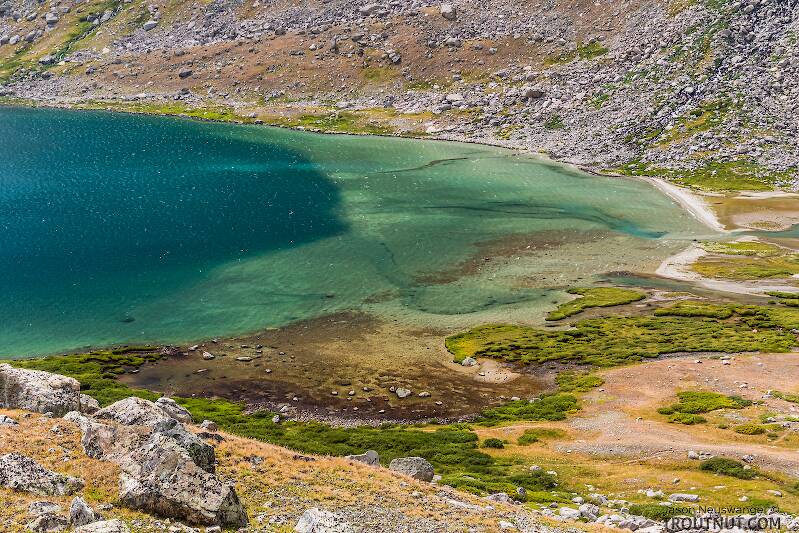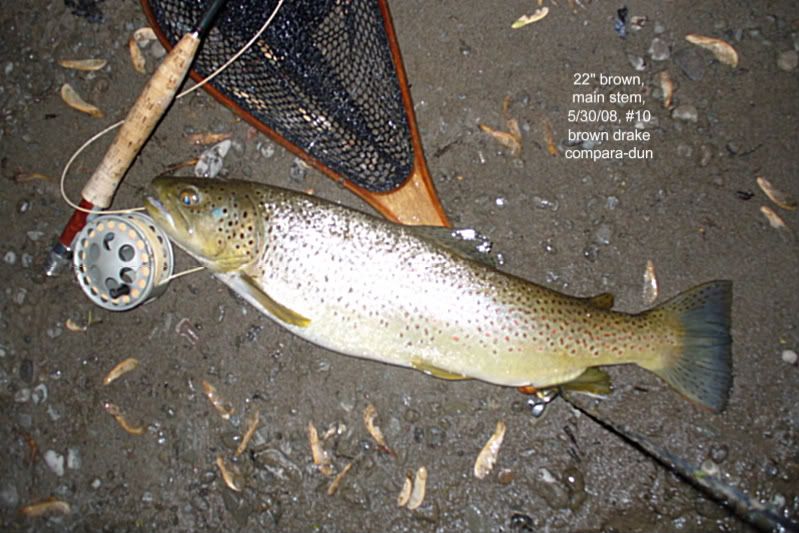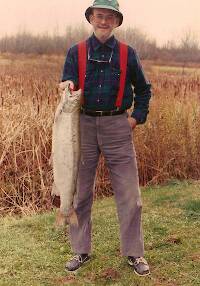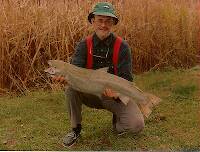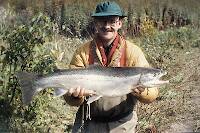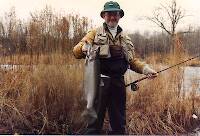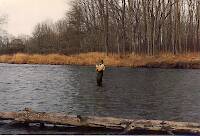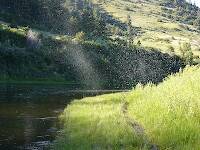
Hex Mayflies
Hexagenia limbata
The famous nocturnal Hex hatch of the Midwest (and a few other lucky locations) stirs to the surface mythically large brown trout that only touch streamers for the rest of the year.
Featured on the forum

Some characteristics from the microscope images for the tentative species id: The postero-lateral projections are found only on segment 9, not segment 8. Based on the key in Jacobus et al. (2014), it appears to key to Neoleptophlebia adoptiva or Neoleptophlebia heteronea, same as this specimen with pretty different abdominal markings. However, distinguishing between those calls for comparing the lengths of the second and third segment of the labial palp, and this one (like the other one) only seems to have two segments. So I'm stuck on them both. It's likely that the fact that they're immature nymphs stymies identification in some important way.

Troutnut is a project started in 2003 by salmonid ecologist Jason "Troutnut" Neuswanger to help anglers and
fly tyers unabashedly embrace the entomological side of the sport. Learn more about Troutnut or
support the project for an enhanced experience here.
Wiflyfisher on Jun 1, 2008June 1st, 2008, 12:22 am EDT
It is about that time to start getting ready for the brown drake hatch. Wondering what others find as the most effective brown drake emerger pattern? I use a wiggle nymph at times, but is time-consuming and tedious tying wiggle nymphs. Suggestions?
John S.
https://WiFlyFisher.com
https://WiFlyFisher.com
Martinlf on Jun 2, 2008June 2nd, 2008, 12:23 pm EDT
I had good luck with a big Quigley style emerger with Green Drakes on the Delaware one year. I used an olive marabou feather for the abdomen, dubbing for the thorax, and a big forward angled deerhair wing with a prominent stubb of the deer hair butts behind. Twitching it in the film produced action.
"He spread them a yard and a half. 'And every one that got away is this big.'"
--Fred Chappell
--Fred Chappell
Wiflyfisher on Jun 3, 2008June 3rd, 2008, 11:56 am EDT
Louis, what is a "Quigley"? So you just use some strands of marabou for a long tail?
I thought you guys had Ephemera simulans out East? (Maybe I was remembering reading about the Green Drakes on the Delaware.)
I thought you guys had Ephemera simulans out East? (Maybe I was remembering reading about the Green Drakes on the Delaware.)
John S.
https://WiFlyFisher.com
https://WiFlyFisher.com
Martinlf on Jun 4, 2008June 4th, 2008, 9:37 am EDT
John, a couple of pictures will be worth a couple of thousand words, I'd hope:
http://www.southeastflyfishingforum.com/flypatterns/displayimage-topn--2-26.html
http://www.uky.edu/~agrdanny/flyfish/ljdecuir/quigley.htm
Instead of peacock for the thorax I used a light greenish dubbing (Caucci's spectrumized for Eastern Green Drake)for the Green Drake emerger.
We have both Emphmera similans and Ephemera gutulatta here in the East.
"He spread them a yard and a half. 'And every one that got away is this big.'"
--Fred Chappell
--Fred Chappell
Wiflyfisher on Jun 4, 2008June 4th, 2008, 10:36 am EDT
Louis, thanks!
BTW, the other day I found 6 plastic containers each containing dyed rabbit fur (red, white, blue, yellow, & black) that Natasi gave me years ago. Their original dyed furs that you then mixed to make their spectrumized fur blends. It has to be around 25 years old. :)
BTW, the other day I found 6 plastic containers each containing dyed rabbit fur (red, white, blue, yellow, & black) that Natasi gave me years ago. Their original dyed furs that you then mixed to make their spectrumized fur blends. It has to be around 25 years old. :)
John S.
https://WiFlyFisher.com
https://WiFlyFisher.com
Wiflyfisher on Jun 5, 2008June 5th, 2008, 1:15 am EDT
Nice fish!!
The Brown Drake Compara-dun is my favorite pattern during the hatch, but I also find an emerger triggers some better action at times.
The "main stem" of the Delaware... Is that below the Junction Pool?
The Brown Drake Compara-dun is my favorite pattern during the hatch, but I also find an emerger triggers some better action at times.
The "main stem" of the Delaware... Is that below the Junction Pool?
John S.
https://WiFlyFisher.com
https://WiFlyFisher.com
Martinlf on Jun 5, 2008June 5th, 2008, 1:17 am EDT
Nice fish, Matt.
John, that is neat about the fur. Jeff of the DRC tells me they blend up the colors when they need them, weighing the fur to get the right amounts. I don't think they use black anymore. The formulae are printed on the dubbing packs.
--Louis
John, that is neat about the fur. Jeff of the DRC tells me they blend up the colors when they need them, weighing the fur to get the right amounts. I don't think they use black anymore. The formulae are printed on the dubbing packs.
--Louis
"He spread them a yard and a half. 'And every one that got away is this big.'"
--Fred Chappell
--Fred Chappell
Wiflyfisher on Jun 5, 2008June 5th, 2008, 4:58 am EDT
I probably have a lifetime supply of their Spectrum pre-blended dubbing packs too. I use them all the time. I blend my own as well, but not too often. A lesson I learned from Natasi was check the blends wet before using. Fur blends tend to darken when wet, which is pretty obvious, but I often forget about it while tying.
I was looking at the 2008 photo gallery for the DRC, there are a lot of nice trout pics. The DR is still one of my favorite rivers. I imagine it gets a lot more pressure than it did back in the early 80's.
I was looking at the 2008 photo gallery for the DRC, there are a lot of nice trout pics. The DR is still one of my favorite rivers. I imagine it gets a lot more pressure than it did back in the early 80's.
John S.
https://WiFlyFisher.com
https://WiFlyFisher.com
Quick Reply
Related Discussions
Topic
Replies
Last Reply
6
Jun 10, 2009
by Martinlf
by Martinlf
5
Jun 8, 2006
by Wiflyfisher
by Wiflyfisher
1
May 23, 2014
by Entoman
by Entoman
0
Jul 7, 2008
by Liljrob
by Liljrob

